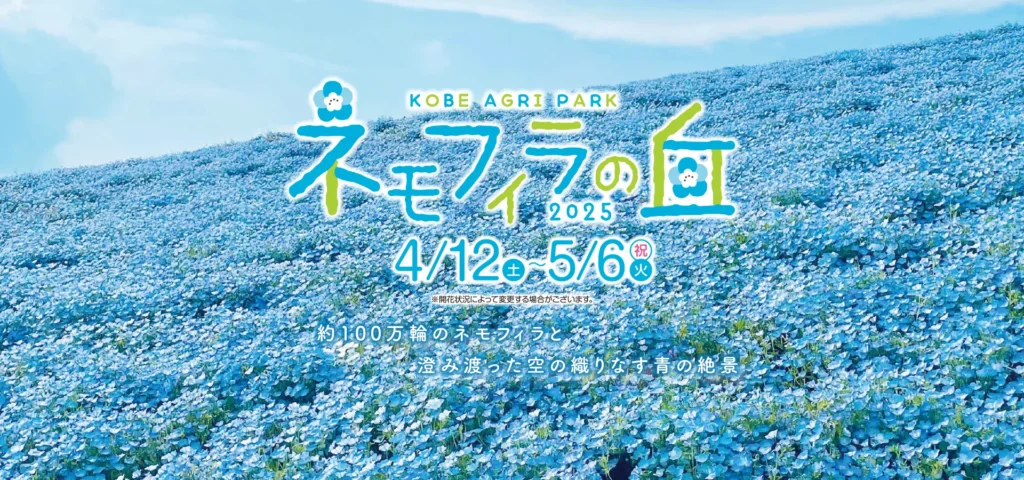Spring is the season when all the plants and flowers that have been sleeping begin to move at once. Why don’t you go out to see colorful plants and flowers that give you a warm spring feeling?
Here are some spots where you can enjoy flowers and plants in Osaka, Kyoto and Kobe.
-INDEX-
[Nemophila] Osaka Maishima Seaside Park, Osaka
[Nemophila]Kobe Agri Park “Nemophila Hill 2025”, Kobe
[Poppy] Expo ’70 Commemorative Park, Osaka
[Yamabuki] Matsuo-taisha Shrine, Kyoto
[Kirishima Azalea] Nagaoka Tenmangu Shrine, Kyoto
[Water Lily] Ryoanji Temple, Kyoto
[Wisteria flowers] Nakayamadera, Takarazuka
[Azalea] Sorakuen Garden, Kobe
[Nemophila] Osaka Maishima Seaside Park, Osaka
Nemophila is a small, lovely flower of clear blue. It is a popular flower in recent years because of its spectacular view of the whole area spreading out like a blue carpet.
About 1 million nemophila plants will be in full bloom in the 44,000 m2 Osaka Maishima Seaside Park, located along the sea with a view of the Akashi Kaikyo Bridge. On Saturdays, Sundays, and national holidays, the opening hours are extended so that visitors can enjoy the orange flowers and the setting sun over the nemophila fields.
There will also be limited edition gourmet foods available only at Osaka Maishima Seaside Park. The most popular item is the soft-serve ice cream, which is a lovely pale blue color like the nemophila flowers. It is recommended to take a picture of the soft-serve ice cream with the nemophila field in the background. The “Kitchen Car Fest in Maishima” will be held at the same time in the park. About 15 kitchen cars from all over Japan will gather to offer visitors the opportunity to taste a variety of Japanese gourmet foods.
There is also an area in the park where visitors can enjoy cherry blossoms and tulips with nemophila, so if you are coming to Japan in spring, be sure to visit Osaka Maishima Seaside Park.
Nemophila Festival: 2025 has been cancelled due to the Osaka-Kansai Expo, and will be held again in 2026.
Usual viewing time: early April to early May
LOCATION INFORMATION
Address
2-chome, Hokkoryokuchi, Konohana-ku, Osaka [MAP]
Access
Take Osaka City Bus No. 81 (bound for Maishima Sports Island)
from Hanshin Namba Line Nishikujo Station,
get off at the "Maishima Sports Island" stop,
and walk shortly.
[Nemophila] Kobe Agri Park "Nemophila Hill 2025", Kobe
A new spot in Kobe, Kobe Agri Park “Nemophila Hill 2025” with approximately one million nemophila flowers in full bloom is now open! Held from April to May, when nemophila are at their best, the harmony of the hills covered in blue nemophila and the clear blue sky is a panorama you will want to capture in your photographs. The park is situated on a small hill, from the top of which you can see the mountains of Kobe.
Kobe Agri Park also has restaurants, barbecue facilities, a winery, a ceramics museum, and other facilities, allowing visitors to enjoy “food” and “agriculture” in various ways along with the nemophilas.
Nemophila Hill 2025: Saturday, April 12 – Sunday, May 11, 2025
Usual viewing time: late April to early May
LOCATION INFORMATION
Address
1557-1 Takawa, Oshibeya-cho, Nishi-ku, Kobe-shi, Hyogo [MAP]
Access
From Kobe City Subway Seishin-Chuo Station, take bus No. 80 or 81 departing from Bus Stop No. 10 or No. 20 departing from Bus Stop No. 11, and get off at “Agricultural Park” bus stop.
[Poppy] Expo '70 Commemorative Park, Osaka
Poppy is a member of the poppy family that has long been cultivated for ornamental and medicinal purposes. The seeds are also used in cooking.
The Expo ’70 Park’s Shizen Bunka-en (Nature Park) and Hana-no-oka (Flower Hill) are decorated with approximately 380,000 poppies. The contrast of colors between the yellow and orange poppies and the fresh blue nemophila can also be enjoyed.
Usual viewing time: early April to early May
LOCATION INFORMATION
Address
1-1, Senribanpakukoen, Suita, Osaka [MAP]
Access
From Hankyu Kyoto Line Minami-ibaraki Station
or Hankyu Takarazuka Line Hotarugaike Station,
transfer over to the Osaka Monorail
and go to Bampaku-kinen-koen Station.
It's a 7-minute walk from there.
[Aomomiji] Minoh Park, Osaka
Aomomiji refers to the leaves of maple trees that turn from young leaves in spring to increasingly darker green. You can enjoy the fresh and crisp leaves of ao-momiji until they turn red in the fall.
Minoh Park is famous for its autumn leaves, but it is also very beautiful in the fresh green season. Enjoy forest bathing surrounded by the sparkling green maples in the sunlight while listening to the murmuring of a mountain stream and the chirping of wild birds.
Usual viewing time: Late April to late May
▼Check this article▼
8 recommended gourmet restaurants in Minoh Waterfall! Cafes & Shops to stop by for sightseeing
Note on how to get to Minoh Waterfall! Points that international travelers should know before going there
LOCATION INFORMATION
Address
1-18, Minohkoen, Minoh, Osaka [MAP]
Access
5-minute walk from Hankyu Minoh Line Minoh Station
Website
[Yamabuki] Matsuo-taisha Shrine, Kyoto
Yamabuki is a deciduous shrub in the rose family with beautiful, almost orange-yellow flowers. The flower has been familiar to the Japanese people since ancient times.
Matsuo-taisha Shrine, known as a place of famous water, has about 3,000 yamabuki trees, which turn the shrine grounds yellow. The Yamabuki Festival is held every year when the flowers are at their best.
Usual viewing time: mid-April to early May
LOCATION INFORMATION
Address
3, Arashiyama Miyamachi, Nishikyo-ku, Kyoto [MAP]
Access
Right by Hankyu Arashiyama Line Matsuo-taisha Station
[Kirishima Azalea] Nagaoka Tenmangu Shrine, Kyoto
It is very familiar in Japan and is often planted as a roadside tree or garden tree. It is loved by many people for its very vivid flowers.
Vivid Kirishima azaleas are in full bloom at Hachijogaike Pond at Nagaoka Tenmangu Shrine. The crimson-tinged path surrounded by azalea plantings more than 2 meters high is magnificent.
Usual viewing time: Late April – early May
LOCATION INFORMATION
Address
2-15-13, Tenjin, Nagaokakyo, Kyoto [MAP]
Access
5-minute walk from Hankyu Kyoto Line Nagaoka-tenjin Station
[Peony] Otokunidera, Kyoto
The peony is a plant that symbolizes beauty and has long been used as a design for crafts and paintings. It produces beautiful and large flowers like roses.
There are 2,000 peony plants of about 30 varieties at Otokunidera Temple. Protected by white Japanese umbrellas for sun protection, the bright pink and red buttons bloom in large profusion.
Usual viewing time: mid-April to early May
LOCATION INFORMATION
Address
3-14-7, Imazato, Nagaokakyo, Kyoto [MAP]
Access
Take the Hankyu bus from Hankyu Kyoto Line Nagaoka-tenjin Station
and alight at Yakushidou.
It's a 5-minute walk from there.
[Water Lily] Ryoanji Temple, Kyoto
Water lilies are striking aquatic plants with flowers that seem to float above the water. It is widely distributed in ponds and swamps.
Kyoyoike Pond at Ryoanji Temple, a World Heritage site, is famous for its water lilies. Not only white but also red and pink flowers cover most of the pond. The flowers often open in the morning and close at noon, so the best time to see them is in the morning.
Usual viewing time: Mid-May to late August
LOCATION INFORMATION
Address
13, Ryoanji Goryonoshita-cho, Ukyo-ku, Kyoto [MAP]
Access
From Hankyu Kyoto Line Saiin Station,
transfer over to the Randen
and go to Kitano Line Myoshinji Station.
It's a 7-minute walk from there.
[Wisteria flowers] Nakayamadera, Takarazuka
The Japanese Wisteria flowers is a species endemic to Japan and is mentioned in the Manyoshu(Collection of Ten Thousand Leaves, refers to the extensive collection of poems compiled during the Nara period in Japan). The long, hairpin-like flowers hang down in a drooping manner. Purple flowers are common, but white and pink flowers also exist.
At Nakayama-dera Temple’s Star Plaza, there is a magnificent wisteria trellis that stretches about 80 meters. The rows of white wisteria flowers look like “clouds floating in a blue sky. The sweet fragrance of the flowers can also be enjoyed.
Usual viewing time: Mid-April to late April
▼Check this article▼
7 Best Spots for Wisteria Flowers in Kansai: The Spring filled with purple flowers
LOCATION INFORMATION
Address
2-11-1, Nakayamadera, Takarazuka, Hyogo [MAP]
Access
Right by Hankyu Takarazuka Line Nakayama-kannon Station
[Azalea] Sorakuen Garden, Kobe
Sorakuen garden is Kobe City’s only Japanese garden, covering an expansive area of approximately 20,000 square meters, where visitors can enjoy the natural beauty of the seasons. In early summer, approximately 4,000 brightly colored white and pink azaleas fill the garden.
Every spring, an event called “Tsutsuji Yuusan” is held, during which important cultural properties are opened to the public, musical concerts, tea ceremonies, and other events can be enjoyed.
Usual viewing time: Late April – early May
LOCATION INFORMATION
Address
5-3-1, Nakayamatedori, Chuo-ku, Kobe, Hyogo [MAP]
Access
5-minute walk from Hanshin Main Line Motomachi Station
[Rose] Aramaki Rose Park, Itami
Roses have long been cultivated for perfumery and medicinal purposes.” It is said to be “the flower that symbolizes love,” and is often used in arrangements and bouquets because of its gorgeous appearance and wide variety of types and colors.
At Aramaki Rose Park in Itami, approximately 10,000 roses bloom in a stylish southern European-style garden. The view of the park, with its sloping terrain and colorful colors, is a must-see.
Usual viewing time: Mid-May to mid-June
LOCATION INFORMATION
Address
6-5-50, Aramaki, Itami, Hyogo [MAP]
Access
Take the city bus from Hankyu Itami Line Itami Station
and alight at Aramaki Bara Koen.
It's a short walk away.
Website
[Japanese Primrose]Rokko Alpine Botanical Garden, Kobe
Japanese Primrose is the largest member of the primrose family, with flower stalks that can reach 80 cm in length. It grows in clusters in wetlands at the foot of mountains.
At the Rokko Alpine Botanical Garden, numerous alpine plants bloom from May to June. The 5,000 or so Japanese Primrose that fill the wetlands are especially breathtaking.
Usual viewing time: Mid-May to late May
▼Check this article▼
Mt.Rokko, Kobe-1 Day Trip|Perfect Panoramic Views and Outdoor Adventure Park!
LOCATION INFORMATION
Address
4512-150, Kita Rokko, Rokkosan-cho, Nada-ku, Kobe-shi, Hyogo [MAP]
Access
Take the Kobe City Bus from Hanshin Main Line Mikage Station
and get off at the Rokko Cable Shita stop.
Ride the Rokko Cable Car to the top.
Take the Rokko Sanjo Bus and get off at the Museum-mae stop.
It's a 1-minute walk from there.
The colorful flowers that bloom in spring are a source of comfort and relaxation for those who see them. Why don’t you take advantage of the warm, sunny weather and visit some of the best places and spots for flowers in Osaka, Kyoto, and Kobe?









































